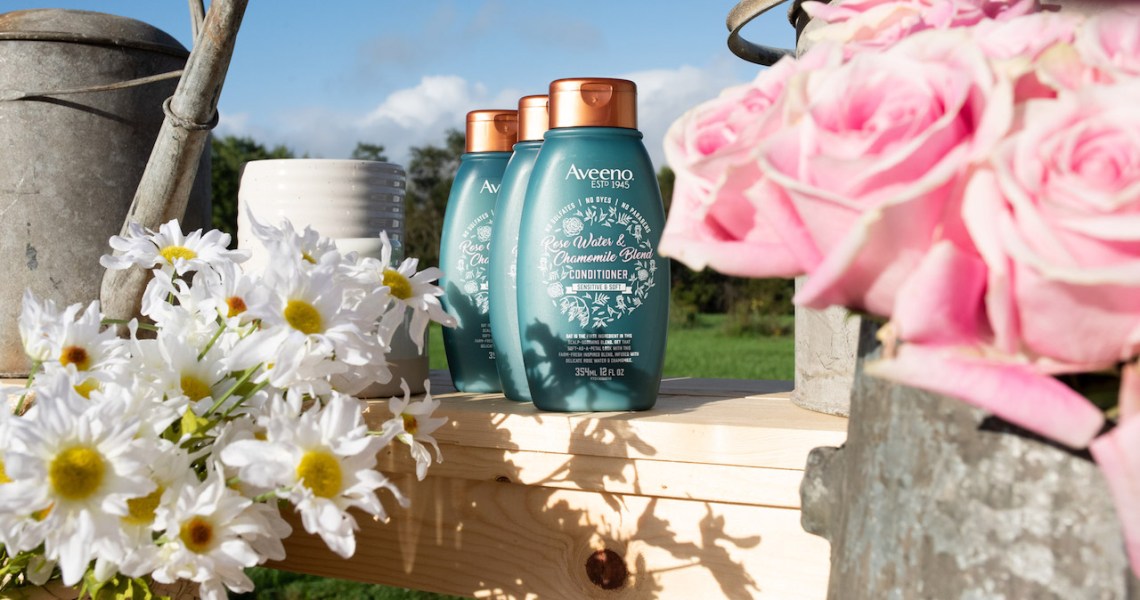Johnson & Johnson’s Aveeno is refocusing on hair care.
This month, the 73-year-old brand, known for its solutions-oriented skin-care products for eczema, dermatitis and sunburns, introduced a revamped, 25-item assortment of shampoos, conditioners, hair masks and styling products across six ingredient-focused collections. The relaunch was 18 months in the making and follows Johnson & Johnson’s July 2016 $3.3 billion acquisition of Vogue International, owner of hair-care brands OGX and Maui Moisture.
“J&J didn’t have a strong presence in hair care; it was under-leveraged. The purchase of Vogue was to get into that business and round out the beauty portfolio,” said Michael Marquis, Vogue International’s president, who is spearheading Aveeno hair care. “We’re strong in skin care, with brands like Neutrogena and Aveeno, but with [the purchase of] Vogue, we not only brought on new crown-jewel brands, but also the capabilities of the hair-care category.”
Aveeno first entered the hair category in 2009, but it was not the focus of the brand until the recent purchase of Vogue International, said Marquis. Prior to the reintroduction into the category this month, Aveeno had an inconsistent hair-care assortment of just 11 products and approached the category in much the same way as others in its range. “We aren’t treating the new collections like skin care or like an afterthought anymore. This is hair care made by hair-care experts,” said Marquis.
Johnson & Johnson’s consumer division is its smallest, after its pharmaceutical and medical devices segments: In its third-quarter earnings, the company’s consumer sector was valued at $3.4 billion globally, compared to pharmaceutical and medical devices groups, at $10.3 billion and $6.6 billion, respectively. But in the earnings report, both the OGX and Neutrogena brands were cited for driving sales among the company’s beauty products.
Other beauty brands like Ursa Major, Playa and Virtue Labs have found using natural and organic ingredients in hair-care products to be a winning strategy. According to market research company Technavio, the hair-care market in the U.S. is experiencing an upswing (by 2022, the category will see a 2 percent compound annual growth rate) because of product innovation and premiumization, due in large part to the demand of natural and organic ingredients. According to market research firm IRI, J&J’s Maui Moisture, which launched in January 2017 and is infused with aloe vera juice and coconut water, saw shampoo sales spike by 60 percent and conditioner sales increase by 52 percent in 2018.
For its part, Aveeno hair care made use of the brand’s signature oat milk ingredient — one of the six collections is dedicated to the hero blend. For the other five lines, it layered the oat milk with more of-the-moment ingredients, like almond oil and blackberry quinoa. Johnson & Johnson has been dabbling in retooling many of its brands, while still incorporating features of its legacy portfolio: In July 2018, it launched C&C by Clean & Clear (a millennial- and Gen Z-focused spinoff of its 62-year-old acne line, Clean & Clear), which came out of the parent company’s new in-house incubation team.
Ad position: web_incontent_pos1
“When you think about Aveeno and skin care, you think about dry skin, but for hair care, the segmentation of needs for a customer explodes. [There’s] thick hair, thin hair, color protection, heavy moisture, clarifying, shine,” said Marquis. “You can’t have one hero SKU [stock-keeping unit]. We knew we had to come out with a set of offerings meeting all needs if we wanted to capture a large segment of the market.” Thus, each of Aveeno’s six collections targets customer concerns, like dull hair, hydration and sensitive scalp.
Though some beauty brands view an efficacious but organic proposition as one best suited to specialty channels — like Ursa Major, which sells at clean retailers like Follain — Aveeno is doubling down on its mass doors, like Walmart, Target, CVS, Walgreens and Amazon. (Each of its 25 products retails for $8.99.) Other mass players have had success with this: L’Oréal’s Garnier Whole Blends hair-care line, which uses select ingredients and is sold in mass stores, generated nearly $122 million in retail sales in its first year.
“Aveeno is a mass brand, so we wanted to focus on satisfying that existing customer where she already is,” said Marquis, who described the Aveeno customer as a “modern mom.” As of now, Aveeno hair care has no in-house direct-to-consumer strategy and cannot be purchased on Aveeno.com. It can only be found on the e-commerce sites of the aforementioned retailers.
“In some ways, we aren’t pulling on the standard tactics beauty brands engage with today: influencers, events. OGX is at Governor’s Ball, but you aren’t going to see Aveeno hair there,” said Marquis, who noted that the brand’s influencer strategy is still in development and that when it does launch, it will center on non-paid influencers across the food and wellness segments. “With Aveeno hair care, we wanted to first get the product and needs right. That’s what our customer cares about most.”




